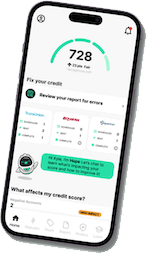What Does A 659 Credit Score Mean?

A credit score of 659 falls into the “Fair” category, meaning you have access to credit but may face higher interest rates and stricter lending terms. While this score won’t completely block you from loans or credit cards, improving it can open doors to better financial opportunities. This guide breaks down what a 659 credit score means, how it affects lending options, and actionable steps to boost your score. Plus, learn how Dovly’s AI-powered credit engine can help accelerate your credit improvement journey.
A credit score of 659 is considered a “Fair” credit score, meaning you have access to credit, but likely at higher interest rates and with stricter terms. While this credit score won’t completely block you from loans or credit cards, lenders may see you as a moderate risk, making it more expensive to borrow. The good news? With the right strategies, you can improve to a good credit score and unlock better financial opportunities. Let’s break down what a 659 credit score means, how it impacts your lending options, and what you can do to boost it.
Lending Options
A fair credit score of 659 won’t necessarily block you from getting credit, but it can make borrowing more expensive.
Credit Cards
You might qualify for standard credit cards, but many premium rewards cards will be out of reach. Expect higher rates, lower credit limits, and possible fees. Some lenders may offer cards designed for fair credit, which often have stricter terms.
Loans and Mortgages
- Personal Loans: Approval is possible, but rates will be higher. Some lenders may require collateral or charge an origination fee.
- Car Loans: You can finance a car, but expect an APR of 7-12%+. A larger down payment can help reduce costs.
- Home Loans: Conventional mortgages may be harder to obtain, as many lenders prefer a credit score above 670-700. However, FHA loans allow approval with credit scores as low as 580.
Other Credit Options
Retail store credit cards and “buy now, pay later” services may be easier to obtain, but they often come with high rates. Some lenders may require a co-signer to approve you for larger loans.
How a 659 Credit Score is Calculated
Your credit score is determined by five key factors. Payment history is the largest portion, accounting for 35% of your credit score. Late payments, charge-offs, or accounts in collections can cause a significant drop, while consistently paying on time helps strengthen your credit history over time. Even a single missed payment can lower your score by 50 points or more.
Amounts Owed, which makes up 30% of your score, refers to your credit utilization. This is the percentage of your credit limit that you’re using. Keeping balances below 30% of your credit limit is important, though staying under 10% is even better. If your utilization is high, paying down balances can have a quick and positive impact on your score.
The length of your credit history accounts for 15% of your score. The longer you’ve had credit accounts open, the better. Closing old accounts can shorten your average account age, which may hurt your score.
New inquiries make up 10% of your score. When you apply for credit, lenders conduct hard inquiries, which can cause a slight drop in your score. Too many hard inquiries in a short time period can have a greater impact. These inquiries remain on your credit report for two years but only affect your score for about 12 months.
The final 10% of your score comes from your credit mix. Maintaining a mix of credit types, like credit cards, auto loans, and mortgages, can strengthen your score by showing that you can manage different kinds of credit responsibly.
Scoring Models & Ranges
Not all credit scores are the same—different models calculate scores slightly differently, which can lead to variations in what creditors see. The average credit score in the U.S. is around 715, based on recent data. This is considered good credit. However, this varies by age, location, and economic factors. The two most commonly used scoring models are FICO® Score and VantageScore®, each with its own versions and scoring criteria.
FICO® Score Ranges
FICO scores are the most widely used, with 90% of top lenders relying on them for credit decisions. Scores range from 300 to 850 and fall into the following categories:
- 300 – 579: Poor – High risk; difficult to qualify for credit.
- 580 – 669: Fair – Subprime borrowers; may qualify for some credit but with higher rates.
- 670 – 739: Good – Considered low-risk; better approval odds and reasonable interest rates.
- 740 – 799: Very Good – Strong credit profile; qualifies for most financing at favorable rates.
- 800 – 850: Exceptional – Excellent; best loan terms and lowest rates.
FICO score has multiple scoring models, including FICO 8 (most commonly used), FICO 9, and industry-specific FICO score versions for auto loans and mortgages.
VantageScore® Ranges
VantageScore is another major scoring model, often used by credit monitoring services. Like FICO, it ranges from 300 to 850, but its categories differ slightly:
- 300 – 499: Very Poor – High credit risk, unlikely to qualify for credit.
- 500 – 600: Poor – Some lenders may approve credit, but terms will be costly.
- 601 – 660: Fair – Higher risk; lenders may require additional conditions for approval.
- 661 – 780: Good – Most consider this a low-risk borrower.
- 781 – 850: Excellent – Indicates strong credit health and qualifies for the best rates.
One key difference is that VantageScore considers trends, such as how a consumer manages balances over time, while FICO score focuses more on individual data points at the time of the request.
Common Myths About a Credit Score of 659
There’s a lot of misinformation about what a credit score of 659 means and how it affects your financial opportunities. Let’s clear up some of the most common myths:
Myth #1: “A credit score of 659 Is Bad Credit”
A 659 score falls into the Fair credit range—not Bad. While it’s not high enough to unlock the best rates and approvals, many lenders still offer loans, credit cards, and even mortgages to borrowers with fair credit. The key is finding creditors who work with this credit range.
Myth #2: “You Can’t Get Approved for a Mortgage With a credit score of 659”
While a higher credit score improves your chances, you can get a mortgage with a credit score of 659. FHA loans, for example, often accept scores as low as 580. VA loans and certain conventional loans may also be options, though interest rates will likely be higher than for someone with a 700+ score.
Myth #3: “Your Credit Score Will Improve Overnight”
There’s no instant fix for credit scores. It takes time to build positive credit habits, such as making on-time payments and lowering utilization. However, disputing errors on your credit report (which Dovly can help with) may result in a faster boost if incorrect negative items are removed.
Myth #4: “Closing Old Accounts Helps Your Score”
Closing old credit cards can actually hurt your score by reducing your available credit and shortening your credit history length—both of which are important for your overall score. Instead of closing an account, consider keeping it open and using it occasionally to maintain a healthy credit mix.
Myth #5: “Checking Your Own Credit Score Hurts Your Credit”
This is a big misunderstanding! When you check your own credit score (through a service like Dovly or a credit reporting agency), it’s considered a soft, not a hard inquiry and doesn’t impact your score at all. However, hard inquiries—such as when someone pulls your credit for a loan or credit card application—can temporarily lower your score.
By understanding these myths, you can make smarter financial decisions and take the right steps to improve your credit score.
How to Improve Your Score
Boosting your score can help you qualify for better interest rates and more financial opportunities. Here’s how:
1. Pay Bills on Time
Payment history is the highest weighted factor. Just one missed payment can seriously affect your score, so consider setting up auto-pay or reminders to ensure you stay on track.
2. Reduce Credit Utilization
If your credit account balances are high, try to pay them down. Keeping your balance below 30% of your credit limit (or under 10% for the best results) can improve your score quickly.
3. Avoid Opening Too Many New Accounts
Every time you apply for a loan or credit card, a hard inquiry appears on your credit report, potentially causing a temporary dip in your score.. Apply only when necessary.
4. Keep Old Accounts Open
The age of your credit history is important. Even if you rarely use an old credit card, keeping it open can help extend your average account age.
5. Dispute Credit Report Errors
Check your credit report regularly for mistakes, like incorrect late payments or accounts that don’t belong to you. If you find errors, dispute them with the bureaus to have them removed.
6. Diversify Your Mix
If you only have credit cards, adding an installment loan (such as a small personal loan) can improve your score. Lenders prefer to see a combination of revolving credit, like credit cards, and installment loans, such as auto loans, mortgages, or personal loans.
7. Pay Off Past-Due Debts
If you have collections or charge-offs, work on paying them off or negotiating a pay-for-delete agreement to remove them from your credit report.
How Long Will It Take to Improve a 659 Credit Score?
The time needed to improve a credit score depends on your financial habits and the factors affecting your score. Here’s a general breakdown:
30-60 Days: If your score is being held back by high utilization, paying down balances can lead to quick improvements. You may see a boost as soon as your creditor reports the lower balance.
3-6 Months: Making consistent on-time payments and avoiding new hard inquiries can steadily increase your score. If you have minor late payments, their impact starts to lessen over this period.
6-12 Months: If you’re working to remove errors or negative marks, the process can take longer. Disputing inaccuracies, diversifying your credit profile, and keeping utilization below 30% (ideally 10%) can help push your score into the “Good” credit range (670+) within a year.
1-2+ Years: If you have serious negative marks (like collections or late payments), they take longer to fade. However, consistent positive habits will gradually build a stronger credit profile.
Conclusion
While a credit score of 659 isn’t the worst, it’s not an excellent credit score either – keeping you just shy of “Good” credit and the better financial opportunities that come with it. By making small but consistent improvements, such as lowering credit utilization, paying bills on time, and disputing errors, you can boost your score and qualify for better rates. If you’re looking for an easier way to improve your credit, Dovly’s AI-powered credit engine can help dispute errors automatically and guide you toward a higher credit score faster.
Frequently Asked Questions





